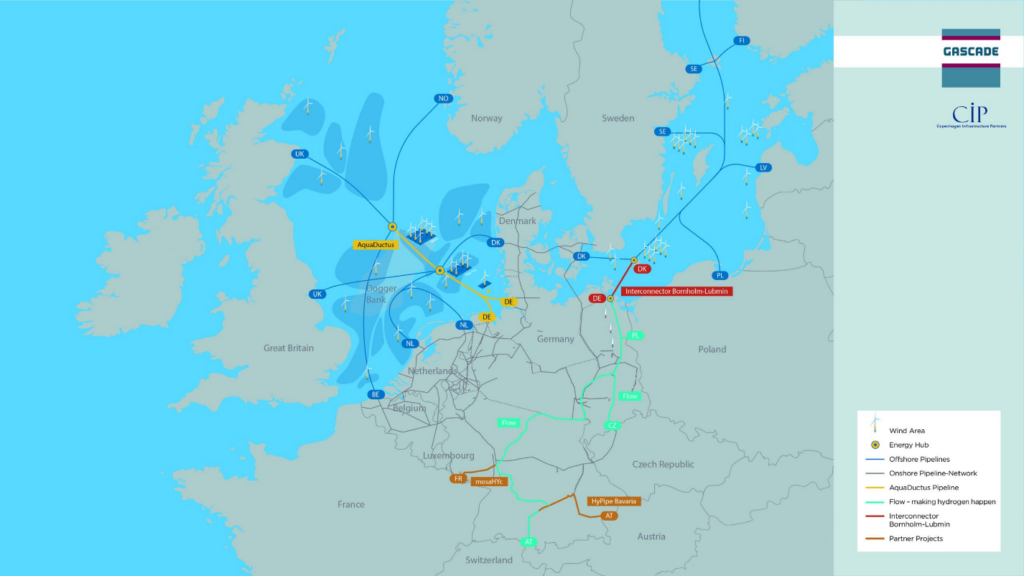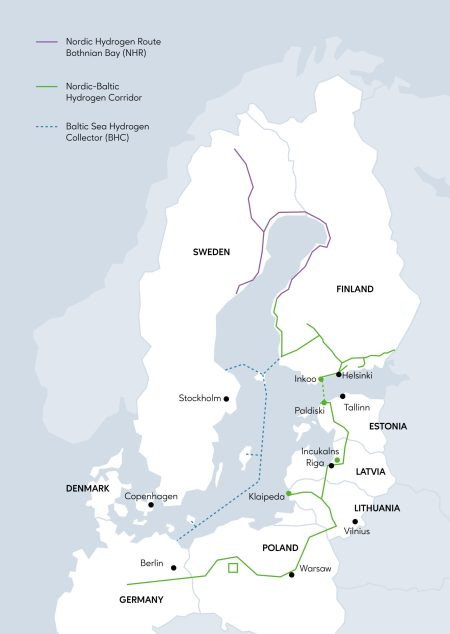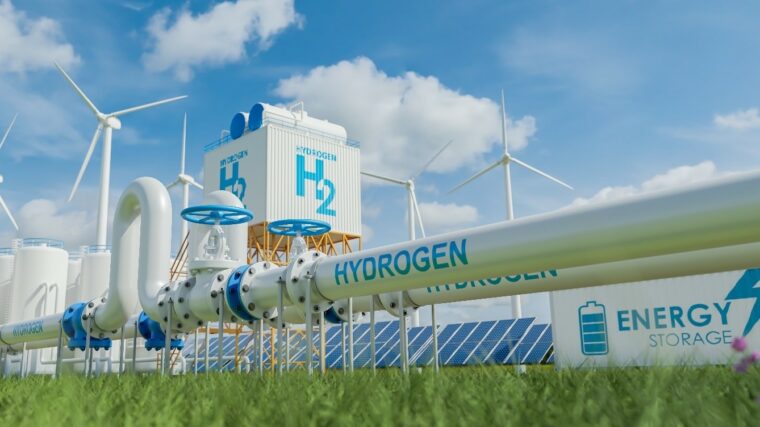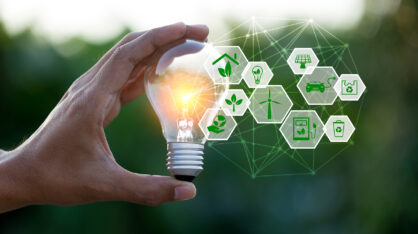Introduction
At the present time, when the influence of renewables is steeply increasing in the energy market, the role and position of green hydrogen as one of the most popular options in shifting from fossil fuels towards renewable energy sources, is also steeply increasing. In the context of this article, we define Green hydrogen (GH) as the one produced by renewable energy sources such as wind or solar power Green hydrogen (GH) production processes. These processes of producing GH are significantly different compared to for example producing GH using natural gas. Nevertheless, when it comes to “transmission”, or moving the gaseous substance over long distances, we see similarities between natural gas and hydrogen pipeline transmission. Existing gas industry infrastructure, knowledge and experience should be viable and useful for the GH industry. In this article, we try to consider the gas infrastructure functioning perspectives and future demands, in terms of the GH economy development.
The common vision of authorities and international energy organizations
The hydrogen strategy for climate-neutral Europe (European Commission, 2020) assumes a phased development of medium range and backbone transmission infrastructure for transporting hydrogen, in parallel with hydrogen production and consumption growth. Also, attention is paid to the existing gas infrastructure conversion for hydrogen transport, considering the energy transition and cost-effectiveness.
The ability of long-distance transportation and longtime storage of GH with minimal energy losses, as mentioned in the International Energy Forum report (Hamilton, Cutright, Schutte-Hiemstra, & Corbeau, 2022), are rather typical characteristics of gaseous substances. This makes a strong argument to utilize the existing gas infrastructure to accommodate GH transportation. Globally, the gas industry engineering experience for the whole gas supply chain is quite significant. However, some limitations relating to hydrogen, such as its lower specific energy per unit volume, may require a larger volume to be stored. Another limitation in hydrogen production is the higher amount of energy required to compress it, as compared to other energy carriers, such as natural gas. It is interesting to note that the biggest part of commercial hydrogen is presently being transported via pipelines due to its economic advantages. Nevertheless, the lack of hydrogen infrastructure is a part of the “chicken-and-egg” problem.
According to the information of Global Hydrogen Review 2022 (IEA (International Energy Agency), 2022a), the hydrogen infrastructure development is complicated by some properties related to hydrogen such as low volumetric energy density, low boiling point, and hydrogen embrittlement of metals. The hydrogen infrastructure development will be driven by hydrogen demand and hydrogen production in high wind and solar resources or carbon dioxide store potential areas. However, gas infrastructure is irreplaceable for low-emission gas transportation (for example biomethane or synthetic methane) without large investments compared to infrastructure conversion to hydrogen. Certain technical solutions for conversion are already in use or simulated, as some of the following examples are presented further in this article. If technical issues are resolved, conversion of the existing pipeline infrastructure to accommodate hydrogen will be a cheaper option than new infrastructure construction. According to the Northwest European Hydrogen Monitor (IEA, 2022b), the ‘Power to X’ vector prevails. The length of North-West Europe hydrogen networks will increase eightfold by 2030 and reach about 12,000 km. Two-thirds of them will be natural gas pipelines repurposed to carry hydrogen. This will reduce significantly the CAPEX by 50-80% compared to any new pipeline construction endeavor.
Gas complex organizations and hydrogen infrastructure development
As presented on the Global Oil and Gas Association IPIECA website (IPIECA, 2021a) and in their publication “Hydrogen: Enabling the energy transition and the pathways to net-zero emissions” (IPIECA, 2021b), the gas industry is characterized by experience, skills and knowledge to develop the hydrogen production from natural gas using the carbon capture, utilization and storage technology for emission mitigation. Regarding infrastructure, it is interesting to consider that hydrogen can be compressed and stored in large volumes by several approaches (for example tanks, underground storage, pipelines, etc.). Currently, the most hydrogen is used where it is manufactured. At the same time, there are definite challenges because of hydrogen properties such as the earlier mentioned low density requiring large volume for storage, risk of old cast-iron pipes and tanks embrittlement, and hydrogen leakage.
| Hydrogen production | Storage, distribution and transformation | Industrial applications | |||||
| Share of all hydrogen-related IPFs | Share of IPFs | RTA | Share of IPFs | RTA | Share of IPFs | RTA | |
| EU | 28 % | 28 % | 1.2 | 33 % | 1.3 | 27 % | 1.1 |
| J p | 24 % | 20 % | 1.1 | 22 % | 1.2 | 28 % | 1.5 |
| US | 20 % | 19 % | 0.7 | 23 % | 0.8 | 19 % | 0.7 |
| KR | 7 % | 6 % | 0.7 | 5 % | 0.6 | 9 % | 1.1 |
| CN | 4 % | 5 % | 0.5 | 3 % | 0.4 | 3 % | 0.3 |
| DE | 11 % | 10 % | 0.9 | 14 % | 1.3 | 12 % | 1.1 |
| FR | 6 % | 7 % | 1.4 | 9 % | 1.8 | 4 % | 0.8 |
| NL | 3 % | 4 % | 2.5 | 2 % | 1.2 | 3 % | 1.8 |
| UK | 3 % | 3 % | 1.1 | 2 % | 0.9 | 2 % | 0.9 |
| CH | 2 % | 2 % | 1.5 | 1 % | 1.2 | 2 % | 1.4 |
| CA | 2 % | 2 % | 1.3 | 2 % | 1.3 | 1 % | 1.0 |
Note: The calculations are based on the country of the IPF applicants, using fractional counting in the case of co-applications.
According to the report (European Patent Office and International Energy Agency, 2023), Germany presently has the biggest share of international patent families (IPF) in the European Union, as can be seen from Table 1 above. On the website of the German Gas and Water Association (DVGW, 2023), we can see that the gas grid is seen as key solution for renewable energy storage due to the ability of hydrogen for long time storing and long distances transporting with almost no loss. The ‘Power to Gas’ technology is supposed to be the most promising in terms of clean hydrogen production. It is declared that the German transmission system operator GASCADE supports the existing gas infrastructure used for hydrogen transmission (GASCADE Gastransport GmbH, 2023a).

The project ‘Flow – making hydrogen happen’ (GASCADE Gastransport GmbH, 2023c), that connects the Danish ‘Energy Island’ Bornholm with the Czech Republic, contains gas infrastructure converting for hydrogen as can be seen from Figure 2 above. About 1 100 km of gas pipelines will be converted for hydrogen (‘Flow – making hydrogen happen’ project, 2022). The project considers the future Baltic Sea offshore backbone to Sweden and Finland connection (‘Flow – making hydrogen happen’ project, 2023b). It’s also provided the partly repurposing of the existing gas pipelines. About 60 per cent of 950 km of ONTRAS Gas Transport GmbH’s start hydrogen network will be natural gas pipelines repurposed for hydrogen (‘Flow – making hydrogen happen’ project, n.d.), etc.
Another interesting project is AquaDuctus which involves hydrogen offshore production and sea pipeline transportation. It’s noted that “Compared to the transport of electricity generated offshore, the pipeline offers clear economic advantages. AquaDuctus will replace five high voltage direct current (HVDC) transmission systems, which would otherwise have to be built. It is by far the most cost-effective option for transporting large volumes of energy over distances of more than 400 kilometres” (GASCADE Gastransport GmbH, 2023b).
The results of the study located on the GASCADE website (GASCADE Gastransport GmbH, 2023) contain the conclusions that offshore hydrogen production connected by pipeline is cheaper than onshore production if the distance between the windfarms and the mainland is more than 100 km.
It seems that the main gas pipeline perspectives in terms of hydrogen backbone development are promising. At the same time, there is an opinion about the upcoming end of the current gas distribution business model (Flis & Deutsch, 2021) which will be associated with zero emissions achievement. Thus, based on German experience, the gas infrastructure functioning perspectives are defined.
The perspectives of Finland in terms of hydrogen transmission
Finland aims to be the European leader in the hydrogen economy in the entire supply chain (Finnish Government, 2023). It’s noted in the Finnish roadmap ‘Hydrogen economy – Opportunities and limitations’ (Sivill, et al., 2022) that large quantities of hydrogen transferred by pipelines are more cost-effective than electrical grid strengthening in terms of renewable balancing. However, it depends on production and demand volumes as well as parallel cost-effective development of various infrastructure (electricity, natural gas, LNG, biogas and hydrogen) is proposed.
Finland participates in two Important Projects of Common European Interest (IPCEI) in the hydrogen sector (Directorate-General for Energy, 2022) that apply both to hydrogen production and infrastructure development. The European hydrogen projects database (IEA, 2022c) contains projects such as the Vantaa-Wärtsilä methanation, the P2X Harjavalta project, the Kokkola H2 plant, the Wärtsilä – Vaasa- Raahe hub Power2AX, and the SHARC – Sustainable Hydrogen and Recovery of Carbon.
In Gasgrid Finland’s vision (Gasgrid Finland Oy, 2023a), the gas infrastructure future can be connected to synthetic methane and possibly hydrogen transmission. The Gasgrid map is shown in Figure 3 below. The document ‘Gasgrid Finland and the Finnish gas sector: Scenarios 2040’ (Gasgrid Finland Oy, 2023b) describes various ways of business environment development. Regarding the gas infrastructure role in the energy system, it is noted that a small role or retaining the basic purpose might be a lack of hydrogen infrastructure or balancing element providing the flexibility of renewable and using ‘Power to Gas’ technology, it might be hydrogen and (or) synthetic methane pipeline transportation. It is important to note that one of the scenarios considers that “Higher education institutions do not train gas expertise, which leads to a skills shortage. Expertise in the natural gas sector is also reflected in the knowledge of other gases, and there is a clear gap in the Finnish field of expertise.” (Gasgrid Finland Oy, 2023b)(p.18).

There are few other hydrogen infrastructure projects worth mentioning in Finland such as the Nordic Hydrogen Route, the Baltic Sea Hydrogen Collector [1], the Nordic-Baltic Hydrogen Corridor, and the Joutseno-Imatra hydrogen (Gasgrid Finland Oy, 2023c). The project map for Gasgrid projects is shown above in Figure 3. To find out and strengthen the interest of customer and producers to be connected to future hydrogen infrastructure, to evaluate the development of hydrogen infrastructure projects, the Hydrogen market consultation was launched on 8.6.2023. It could be supposed that this approach is one of the steps to solve the “chicken-and-egg” problem, as mentioned earlier in this article. The more participants are involved to the future hydrogen market, the more cost-effective infrastructure projects could be. The synergistic effect can be excellent.
For the future of hydrogen supply in Finland, it will be very important to achieve more positive project results to integrate into the future European hydrogen market and become the European leader in the entire supply chain of the hydrogen economy.
Conclusion
A small part of the information sources has been used in this article but this information allows us to see that the question about gaseous substances infrastructure functioning prospects in the context of the energy transition is complex and multifaceted. Nevertheless, we think that fundamental steps have been taken and pipeline gas transportation technologies have definite perspectives.
Certainly, hydrogen transmission technology cannot be a replica of natural gas transmission and distribution technology. There are a lot of differences between natural gas and hydrogen characteristics. Some of them, for example, are connected with the safety field. At the beginning of the hydrogen transportation development, compared to natural gas, the focus is likely to shift towards industrial hydrogen consumers. However, in our opinion, much will depend on technical issues and solutions and much remains to be explored and accomplished towards the hydrogen economy development. At the same time, the similarities of gases tell us that knowledge, skills and experience of gas technologies, such as gas pipeline transmission, shouldn’t be reduced and (or) forgotten. These should be developed and increased as soon as possible to train gas experts.
This article has been produced as student work within the framework of the Energy Technology Bachelor’s study program at the Vaasa University of Applied Sciences. The Author of this article has several years of experience in the gas supply industry and is pursuing further education at the University of Applied Sciences. The editor of this article is a lecturer in the field of Energy Technology.
[1] As we can see, the project is connected with the project ‘Flow – making hydrogen happen’ mentioned above




